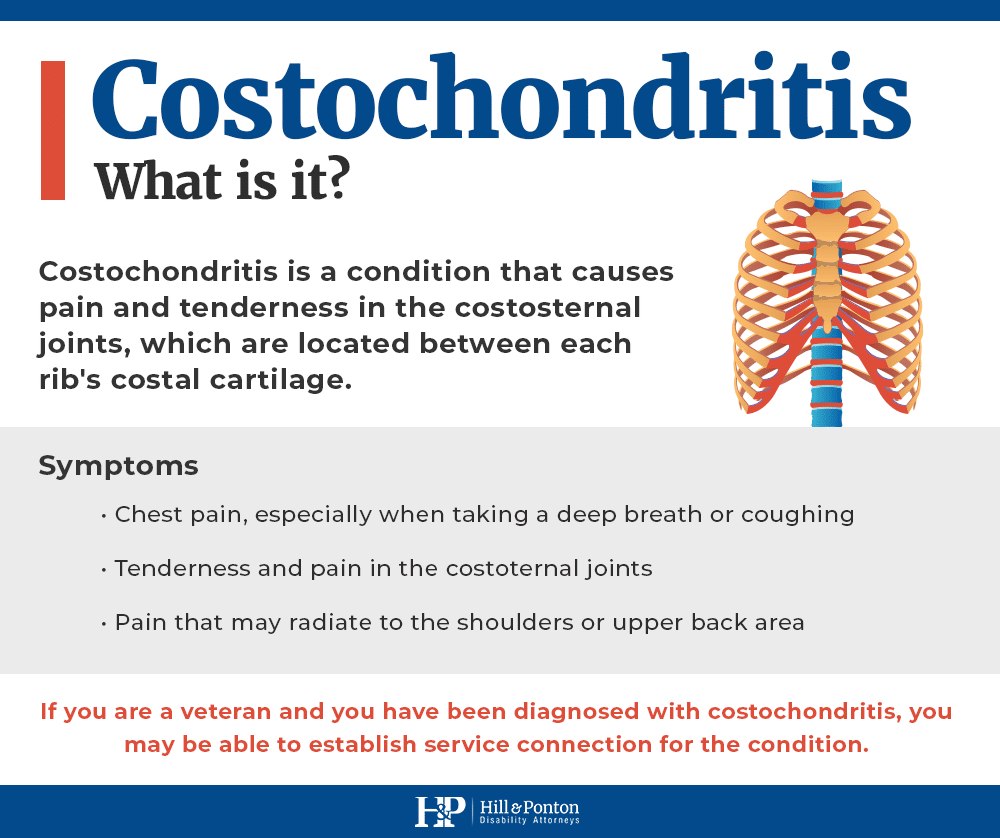If you’re a veteran diagnosed with costochondritis—an inflammation of the cartilage connecting your ribs to your sternum—you might be wondering how the VA rates this condition. Below, we’ll explain how the VA evaluates costochondritis, how to establish service connection for chest pain, and tips for maximizing your disability benefits.
What Is the VA Disability Rating for Costochondritis?
VA rates costochondritis at 0%, 10% or 20% under diagnostic code 5321, used for rating conditions that affect thoracic muscles and cause chest pain:
- 0% rating – Slight
- 10% rating – Moderate
- 20% rating – Severe or Moderately Severe
What Is Costochondritis?
Costochondritis is a condition characterized by pain and tenderness in the costosternal joints—the cartilage connecting the ribs to the sternum. While it often affects one side of the body, some veterans experience symptoms on both sides, impacting daily activities and quality of life.
Physical activity, particularly after military service, can sometimes exacerbate the condition, leading to occasional incapacitating episodes. The pain may also spread to surrounding areas such as the shoulders or upper back.
Common Symptoms of Costochondritis
- Chest pain: Often sharp and severe, it can mimic a heart attack, particularly during deep breaths or coughing.
- Tenderness: Pain may be felt when pressing on the sternum, rib cage, or affected joints.
- Radiating pain: Discomfort can spread to the shoulders, upper back, or other areas near the costosternal joints.
Costochondritis is often confused with Tietze syndrome, as both conditions share symptoms like chest pain. However, Tietze syndrome is rarer and typically affects only one costosternal joint, whereas costochondritis may involve multiple joints.as they share many of the same symptoms like chest pain. However, Tietze syndrome is a rarer condition and usually only affects one costosternal joint rather than multiple like costochondritis does.

How to Get VA Disability Benefits for Costochondritis
If you are a veteran diagnosed with costochondritis, you may be eligible for VA disability benefits. Establishing service connection is key, and there are several ways to do this:
1. Direct Service Connection
The most common method for service connection is to prove that your costochondritis was directly caused by an event or incident during your military service. To qualify, you must meet the following criteria:
- A Current Diagnosis: You need a current diagnosis of costochondritis or evidence of the condition.
- An In-Service Event or Injury: Provide proof of an event, injury, or incident during service that may have caused or contributed to the condition.
- A Medical Nexus: A statement from a medical professional linking your costochondritis to your military service is essential. For example, a doctor treating your orthopedic issues can provide an opinion that supports your claim.
Pro Tip: Gather military records, medical records, and any relevant documentation that ties your condition to your service.
2. Secondary Service Connection
If costochondritis is caused or aggravated by another service-connected condition, you may qualify for secondary service connection. To establish this, you must:
- Show that your costochondritis is directly linked to an already service-connected condition.
- Provide medical evidence supporting the connection between the two conditions.
For example, if a service-connected back injury altered your posture, leading to strain in the rib cage and resulting in costochondritis, this could qualify as a secondary service connection.
3. Service Connection via Aggravation
If your costochondritis pre-dates your military service but worsened during active duty, you may be able to establish service connection via aggravation. To qualify:
- Prove that the condition existed before entering the service.
- Demonstrate that military service aggravated or worsened the condition beyond its natural progression.
- Provide medical evidence showing how service contributed to the aggravation.
Reminder: Each of these claims requires strong medical and military documentation to support your case. A detailed nexus statement from a qualified medical professional is often critical to success.
C&P Exams for Costochondritis
To establish service connection for costochondritis, you will need to provide compelling evidence, including medical documentation. A Compensation & Pension (C&P) exam may be required as part of the process. During this exam:
- A VA-appointed medical professional will review your medical history, assess your symptoms, and confirm your diagnosis.
- They will evaluate how the condition affects your daily life and determine if your costochondritis is linked to your military service (e.g., chest trauma sustained during active duty).
Providing thorough documentation, such as medical records and a nexus letter from your doctor, can strengthen your claim.
TDIU for Costochondritis
Total Disability Individual Unemployability (TDIU) benefits provide compensation to veterans who are unable to maintain substantially gainful employment due to their service-connected disabilities.
Eligibility for TDIU with Costochondritis
- If costochondritis is your only service-connected disability, it may be challenging to qualify for TDIU unless it severely impairs your ability to work.
- However, if costochondritis is combined with other service-connected disabilities, leading to a combined rating of at least 70%, you may qualify for TDIU.
In such cases, you’ll need to demonstrate that costochondritis and your other service-connected disabilities collectively prevent you from securing and maintaining gainful employment. A strong application includes medical evidence and statements explaining the impact of your conditions on your ability to work.
Get Help Appealing a Denied VA Claim for Costochondritis
If you are denied service connection for costochondritis, you have the right to appeal. However, if costochondritis was awarded service connection but they lowballed the disability rating they gave you, you may also appeal that. Make sure your symptoms line up with the rating they gave you. You can also get a free evaluation of your case here. We’ll point you in the right direction!




